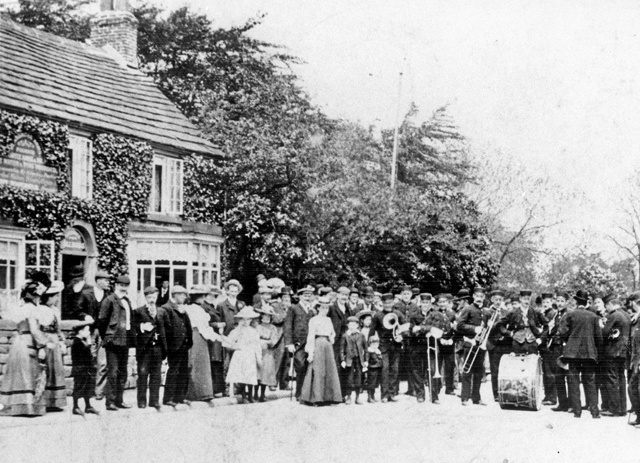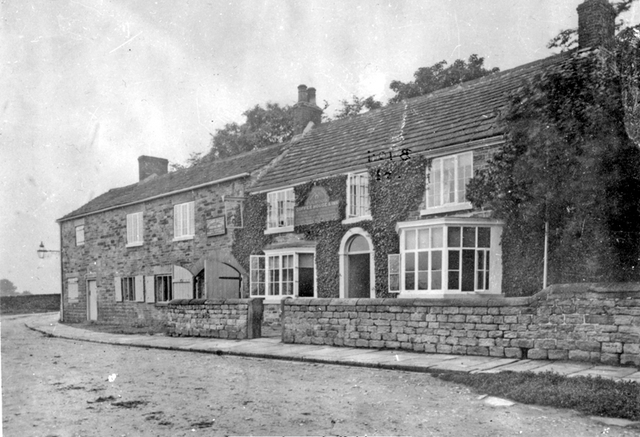» Main Index

» Search This Site

» Submit Update

» Contact Us


|
|

|
Home > Yorkshire >
Sheffield > S10
> Blacksmiths Arms
Blacksmiths Arms
 |
|
Picture source: Keith
Pitchforth |
|
|
|
|
The Blacksmiths Arms was situated on
Old Fulwood Road. This pub was also known as The Hammer & Pincers and closed in 1888. |
|
Source: Sue Hedges |
|
|
The location of the Hammer and Pincers
was on the present Old Fulwood Road near the Ranmoor garage It was known by
both these names over the years
The first reference to the public house in the newspapers was in 1835. In
1847 Mr Nicholson advertised that he would hold an auction of land ‘at the
Farewell Harrison Inn’ Three years later George and William Eadon announced
that would hold an auction of farm and land at the ‘Blacksmiths Arms.’ The
Ordnance Survey map of 1855 shows the ‘Hammer and Pincers’ PH. So the place
had been known by three different names over a short period.
In 1858, the Hallam and Ecclesall Farmers' Club held their annual exhibition
at the Blacksmith’s Arms and a year later the landlord, David Woodhouse
announced that he ‘begs most respectfully to inform his Friends and the
Public that he has formed a CRICKET GROUND near the above Inn’ with the
first reported match between Whiteley Wood and Dore. This time, the house
was named the Hammer and Pincers Thus the public house was the location for
auctions, sporting competitions (e.g. pigeon shooting) inquests, hustings
meetings and annual dinners – for example the Hallamshire Hunt in April 1863
and later years.
But the Hammer and Pincers was not without its darker side. In 1871 Jane
Worrall who held the licence applied to transfer it to the Industry Inn but
this was refused as she had been fined for permitting drunkenness and thus
was not a person of good character fit to conduct a public house. When she
applied again in January 1872, her solicitor produced evidence of character
from Daniel Coupe of Storth House and John Pritchard and this was sufficient
for her application to be granted. It was also a place of temptation for
some as the sad case of George Marsden related earlier attests.
George Marsden who was 67 years of age in 1884. lived at Crimicar farm about
a mile from the pub. He had been at the pub one night early in January 1884,
leaving about 8 pm. He had had too much to drink. He was found dead about
two hours afterwards by his son, John, who had gone to look for him. George
was lying face downwards in a ditch which runs along the side of Crimicar
lane with a hand on each side of the ditch, but his body was wedged fast
between the banks of earth.
The second half of the nineteenth century saw the creation of a mass
movement for temperance. The United Kingdom Alliance was formed in 1853 and
in 1881 there was a meeting at the Wesleyan Chapel in the Mayfield Valley to
discuss the ‘local option’ that is the right of local ratepayers to veto the
granting of licences in their area. John Hewlett, the vicar, made his views
clear in a letter to the chairman, claiming to have seen ‘not a little of
the sad effects of such houses of temptation’ and strongly agreed that ‘the
inhabitants should have a voice in the matter’ by whom, of course, he meant
the ratepayers. He then went on: ‘Pray the men to keep away from the
unsatisfying though expensive pleasures of the public-house; and pray the
wives to make the home more attractive to the wearied husband.’
Hewlett saw an opportunity in 1888 to put his views into effect. As the
Telegraph journalist said ‘Hewlett has had his eye on the "Hammer and
Pincers" for a long time.’ Under his direction, there had been a cafe at
Brook Cottage about half a mile from the public house. The lease for the
cottage was not renewed but the landlord of the Hammer and Pincers left
about the same time. Now the freeholder of the land on which the public
house sat was Henry Dixon of Stumperlowe Hall who was vicar’s warden of the
church and so ‘Mr. Hewlett had no difficulty is inducing that gentleman to
consent to the licence lapsing.’ (Sheffield Independent)
Hewlett worked energetically to complete the project. He solicited funds
from the leading people of Sheffield such as Henry Stephenson, the local MPs
Howard Vincent and Frederick Mappin, Aldermen Clegg and Gainsford, the Cole
Brothers and more cryptically from a retired and an active wine merchant
(possibly Duncan Gilmour). He also organised an Industrial Exhibition at the
School and the Sheffield Independent reported at the opening ceremony. The
exhibition was, the reporter noted:
In aid of a fund to secure for the parish permanent reading room in
connection with the Church of England Temperance Society. At present the
only accommodation which the poorer inhabitants of the parish have for
reading and other social enjoyment is a small cottage which was leased for
three years.’
This sense of needing to control the social activity of poor and the lower
classes pervaded much of the late 19th century discourse although how
successful such control was is less clear. Andrew Walker surmised, in an
essay concerning ‘Religion, Politics and Leisure in Attercliffe’ that ‘the
degree of control imposed was by no means substantial’ and that ‘respectable
working-class citizens’ were behind ‘rational recreation’ activities in the
district1. In Fulwood, the Ploughing Association was managed by the local
farmers who could be counted amongst the respectable working class.
Both papers reported the opening ceremony of the cafe. The Telegraph article
concluded by saying that there ‘will be all possible kinds of outdoor
recreations, that town toilers who take their walks that way may literally
have “high jinks."’ The independent report was much more detailed, noting
that the rooms ‘are prettily decorated and neatly furnished, and people can,
if they choose, engage a private sitting room and bedrooms. Picnic parties
can also be accommodated, a summer house and field being at their service’
before remembering that ‘of course the new inn is intended chiefly for the
use of the working men of Fulwood.’
The working men of Fulwood were absent from the opening ceremony, at least
the paper gave no hint of their presence. Unsurprisingly, it was the vicar
who presided at the inauguration and those present included the Mayor of
Sheffield, Archdeacon Blakeney, Alderman Gainsford, the Master Cutler and
his wife, and Henry Dixon. Hewlett listed the contributors including a
church member, Miss Hobson, who had left £100 in her will and her executors
paid an additional £35 that she had promised before her death. Henry Dixon
had upgraded the property at a cost of £200. The Mayor said he had been
vilified for trying to stop the ‘drink traffic’ but he was very glad to see
this project completed.
Although the Mayor was sure that ‘those who patronised it would not be dealt
with as if it were charitable institution, but would have full value for
their money,’ it was to be overseen by a committee that included Mrs
Hewlett, Mrs Gainsford, Mrs. W. W. Harrison (the wife of the treasurer)
Charles Nowill and William Naylor.
Over the early years there were a number of fund-raising events reported and
the Hamer and Pincers was the location of an Independent Order of Foresters
Court. But there are no reports of association dinners or sporting events
being held at the café in the years after its conversion and the patrons of
the former public house had the choice of alternative houses. But the coffee
house was still in operation into the 20th century and Arthur Wolstenholm
was listed as the proprietor in trade
1 Aspects of Sheffield volume 2
directories between 1905 and 1919 and there is anecdotal evidence that the
café was still in use as a social centre into the 1920s when dances were
held in the upstairs meeting room.
The building is now a private house. |
|
Keith Pitchforth (August 2020) |
|
|
|
Do you have any anecdotes, historical information, updates or photos of this pub? Become a contributor by submitting them here.
You can also make email contact with other ex-customers and landlords of this pub by adding your details to this page. |
|
|
|
Other Photos |
 |
|
Picture source: Keith
Pitchforth |
|
|